Creating Dynamic Dialogue: A Script Analysis Guide to Compelling Conversations
Posted: April 14, 2023 | Updated: April 20, 2023
Posted In: Articles
When you think about your favorite movie, T.V. show, or novel, what comes to mind first?
The plot or theme is often what people first describe, but even a well-crafted storyline is not sufficient enough to keep us entertained.
Suspenseful moments and scenic settings would be nothing without captivating characters who bring multiple perspectives to life. Memorable characters stay in our minds for a number of reasons. Maybe it’s the way we see ourselves through their stories, or their distinct characteristics that appeal to us?
We are naturally drawn to characters that possess imperfections, flaws, and undesirable intentions, it’s what makes them human and subsequently relatable.

If we were really to get to the bottom of what makes a great or iconic character, we would have to examine their presence within the story and this is done a number of ways:
- Examining their interactions with others
- How they express or define their own identity to audiences
- The ways in which their definable traits impact their personalities
The best way of going about this kind of script analysis is examining their dialogue and the impact it has on a story.
Dialogue is an essential component of storytelling, no matter the type of content. Perhaps the most powerful tool in a creator’s toolbox, it allows script writers to convey these character traits, emotions, and motivations while simultaneously moving the plot forward, no matter the stage directions.
However, writing engaging dialogue that captures the reader’s attention is easier said than done. Crafting natural-sounding conversation that is both dynamic and compelling takes practice and skill.
This guide will use script analysis to examine the key components of successful character dialogue and the ways in which it influences great screenplays.
For more information on script analysis and its intended meaning, see the article linked here.
If you are also interested in discovering more about character development, this article is worth a read through.

Dynamic Dialogue Begins With Strong Character Relationships
Any kind of script analysis will tell you that dynamic dialogue is so much more than significant words. In fact, dialogue is dependent upon the words shared between two people (it’s even written in the name itself).
Character interactions drive the action, explain the story, and provide essential background information for audiences to piece together meaning about the characters given circumstances.
This dialogue includes words that the script writer wants to be uncovered by audiences (through their spoken interaction) and words purposefully left unsaid (the character’s subtle body language clues and movements).
We can identify a married couple’s relationship to one another through the significant words shared over the course of a scene. Audiences gauge the appropriate response to their relationship through a number of components within their dialogue:
1. The frequency at which the characters speak to one another
- How often a pair of characters converses in a scene provides evidence to the audience regarding the importance of their relationship.
2. The depth of the conversation they are having.
- Are they speaking for a long time or a short period of time? Are they speaking about their relationship to one another or in conversation with other characters?
3. Which characters in the story converse the most.
- If they are both leads in the story, but never interact with each other, they could be navigating two independent story worlds despite their characters’ objectives in a scene.
StoryFit’s script analysis engine makes uncovering these essential dialogue elements easier than ever before, taking the guesswork out of character relationships.
Take a look at our script analysis Character Network graphic for the 2022 Drama-Thriller, Don’t Worry Darling.
This chart represents a visual map of a script’s main characters’ interactions and their overall level of centrality (their percentage of shared interactions with other characters).
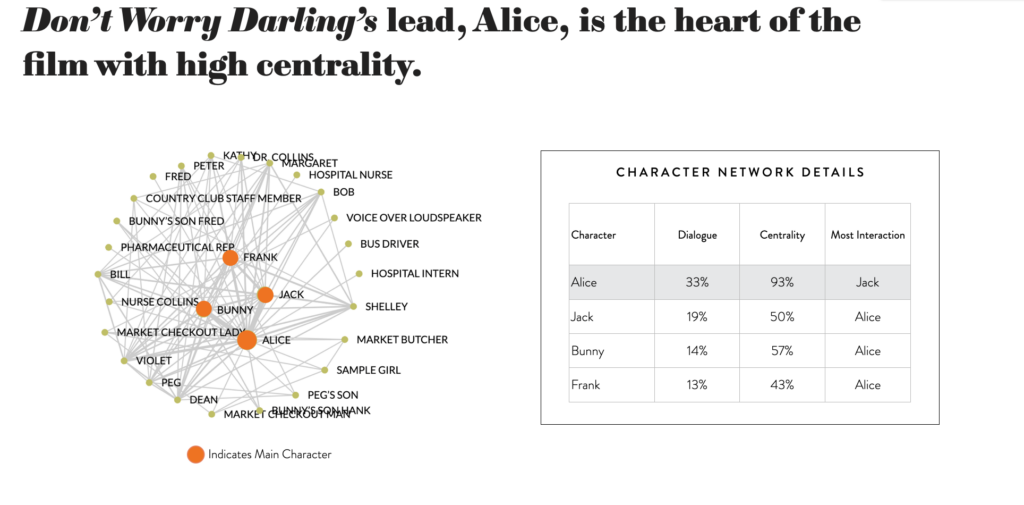
As you can see, Alice is the lead of the film with 33% of the dialogue, but she is not the only important character to the storyline. Jack, Bunny, and Frank all exist as essential characters in the script and provide support to Alice for the broader premise.
With 93% centrality, she has shared interactions with almost all characters in the film, interacting mostly with Jack – her intended love interest. This confirms that their relationship is a crucial one to the story, and that as the lead, she is prominently connected to most other side stories (with Jack, Bunny, and Frank interacting mostly with her).
The super objective of this chart pinpoints the key breakdown of the script’s dialogue and provides a helpful quantification for many of the questions screenwriters and producers often ask themselves throughout the production process:
- What is the breakdown of the cast? Which characters drive the narrative? Which character’s objective is most essential to the story?
- Which characters and relationships are at the heart of the story? Do the characters with the primary relationship of the story speak mostly to one another?
- My leads talk a lot, but are they in a lot of scenes?
- Who is the story pairing together? What type of relationships are at the forefront – Is this a buddy comedy? Mother-daughter drama? Love story? Revenge story?
Don’t Worry Darling’s Character Network looks very different, for instance, than a story revolving around one primary character.
When you give the 2023 Best Picture nominee, Tár’s character breakdown a close reading, you’ll notice significant changes in the graph.
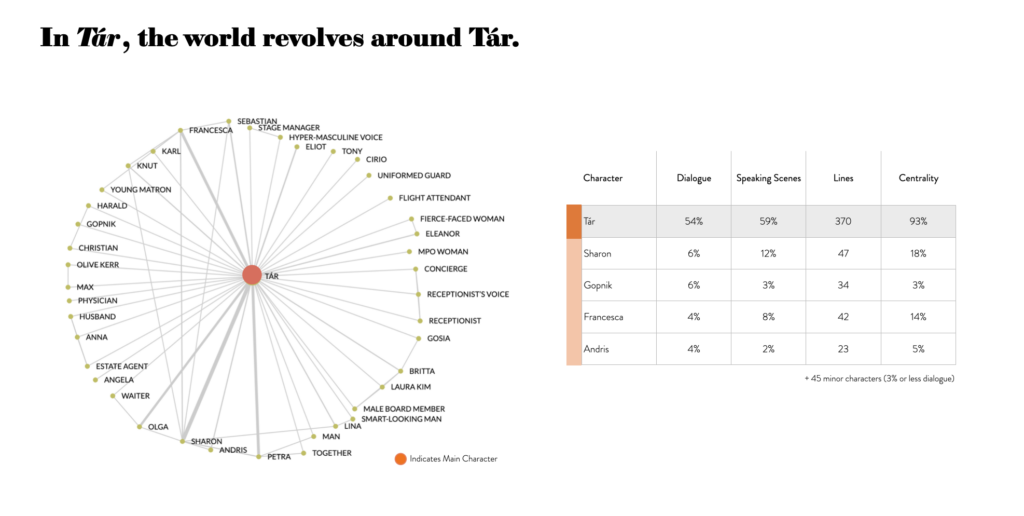
Tár’s character network, which is shaped like a near-perfect wagon wheel revolving around Lydia Tár, illustrates the film’s tight focus on a single lead’s perspective. Lydia not only drives the central narrative, all other secondary characters literally revolve around her story world.
Few secondary characters used in the film interact with each other without Tár’s involvement, and this promotes audiences to stay trapped within her world and story perspective, as she is the only narrative we are allowed to see.
As described in Variety, “Tár is hyper specific about Lydia’s world, down to its most rarefied details.” We become engrossed in her character journey, the challenges she faces, and the relationships she builds with others that ultimately come crumbling down to create tension.
Dynamic Dialogue is Well Distributed Throughout the Script
Strong characters and their relationships to one another are crucial to any compelling narrative, but it remains just as important that their character presence (and dialogue frequency) continues throughout the script.
Main characters that speak or change action in various scenes are more likely to be regarded as effective leads than characters that drop off at key points or leave the story all together.
Our AI script analysis analyzes this type of dialogue via our Character Blueprint graphic.
StoryFit’s Character Blueprint consists of a scene-by-scene breakdown for all major and minor characters within the script that speak or have presence within a scene. If they are referenced in the story, but are not written to be physically present or have no spoken dialogue, they do not appear in the blueprint.
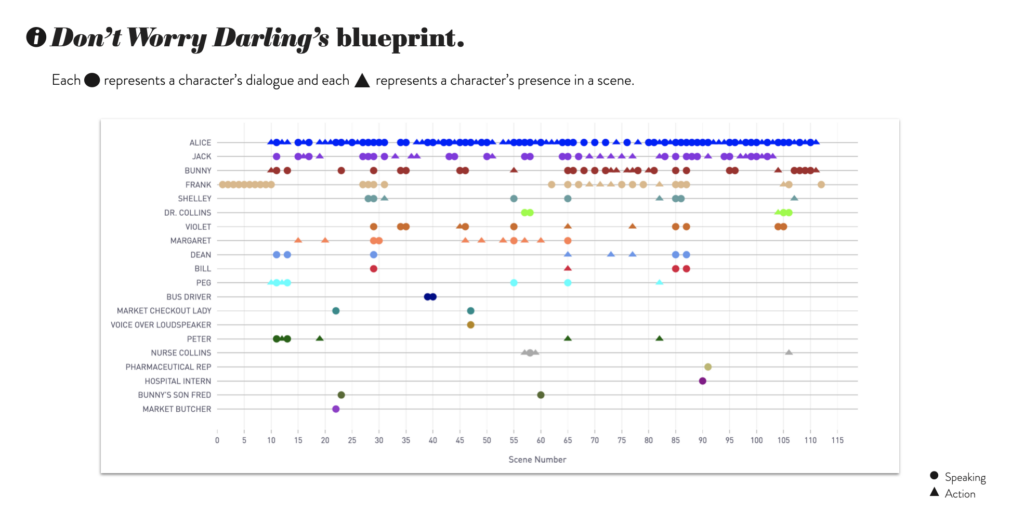
Don’t Worry Darling’s Character Blueprint is a great example of a successful leading presence. Alice, the film’s primary lead, has both dialogue (speaking) and presence (action) in all acts, signifying her importance to the narrative and the overall storyline. Though Jack and Bunny play smaller roles in the story, their presence is also well dispersed throughout.
As any viewer can attest to, secondary characters are just as important (if not more so) than leads. They provide alternative perspectives (adding complexity to the plot and helping audiences understand the story’s world better). They create conflict, serve as a foil highlighting a protagonist’s strengths and weaknesses, and add richness and depth to the story to advance the plot forward.
If secondary characters are virtually invisible in the blueprint (they lack significant speaking or scene presence) this is a major red flag for a scene partner.
While secondary characters in Don’t Worry Darling like Frank, Shelley, and Dr. Collins are present in important scenes and add to Victory’s picturesque and idyllic community, they could benefit from further incorporation, especially within all the lines in the second act.
Some memorable films don’t incorporate their leads in the same effective way.
Take Star Wars: The Phantom Menace, for instance. In this movie, we can see that Anakin (one of the primary leads in the story), is absent for a majority of the first act.
When compared with another successful Action-Adventure-Fantasy film, Lord of the Rings: The Two Towers, we can see that there are gaps in the primary character’s dialogue, but these gaps coincide with other characters’ breaks in speech. This means the scene doesn’t involve any type of dialogue and is likely a scenic overlay or action/fight montage. The primary characters consistently interact within the film, dropping off and coming back together, exhibiting the importance of their relationship to one another.
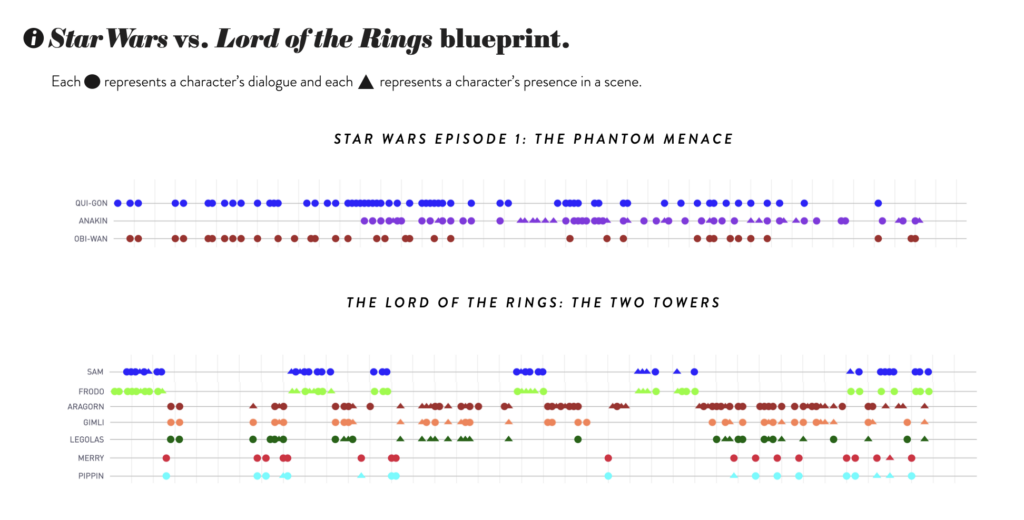
Dynamic Dialogue Strengthens Character Scores.
This one’s simple. Dynamic dialogue that speaks to a character’s intrinsic motives, goals, perspective, and personality strengthens them as whole.
Our script analysis process will tell you that character dialogue doesn’t necessarily have to display individuals in a positive light, so long as it showcases them authentically to audiences who can develop their own interpretation.
In fact, it’s often the negative traits and drivers (greed, selfishness, or narcissism) that compels an audience to fall in love with them. Dialogue that personifies these authentic qualities can make or break your character.
Examining our script analysis character tool helps us evaluate the strength of a script’s major and minor characters.
The script analysis score is an overall indicator of a character’s potential, as our AI engine measures the defining traits that an audience will recognize. Strong characters are the foundation of good stories.
A higher score is always better, as this character assessment correlates to the success of a film or series.
But how are character scores determined?
Character scores are a compilation of a character’s prominent and impact level traits (traits that index in the top 25% and 10% for all characters within the genre).
For example, if a lead in a Romantic Comedy indexes in the top 10 or 25% for all characters within that genre for traits like Loves Family, Authentic, Multi-Dimensional, and Thought Provoking, they would have a character score of 5.
Let’s take a look at the Character Score for a breakout television character like Fleabag.
Fleabag is the lead in Fleabag, a dry-humored, dark comedy about a woman navigating life and love in London while simultaneously coping with grief. She is one of the few engaging examples of a Gold Standard character.
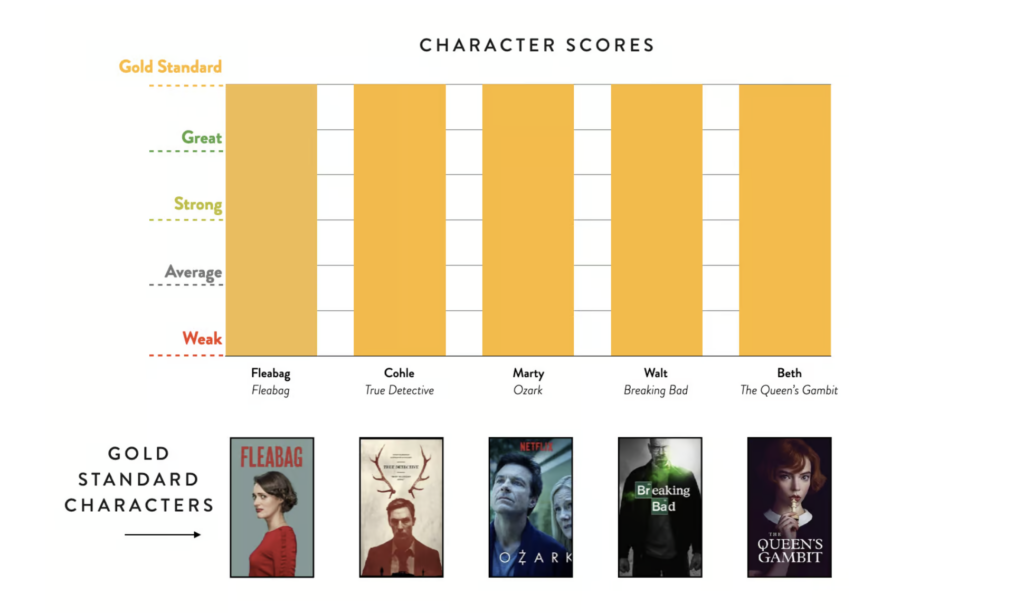
Fleabag’s dialogue meets the Gold Standard!
Audiences love Fleabag for her highly cringeworthy personality and vulgar conversations with friends, family members, and herself. The structure of the T.V. show verbalizes her internal thoughts and expresses them externally through her dialogue.
Successfully breaking what screenwriters and industry professionals know as the “fourth wall.” Fleabag’s acknowledgment of the audience and/or the artificiality of the environment creates a comedic and heartfelt connection with her viewers in a way that is distinctive to her character.
Part of what sets her apart from other leads is her lack of altruistic qualities. Our script analysis confirms that she indexes highly for traits like Brutal, Greedy, Crude, and Vulgar – becoming an anti-hero of sorts. However, it is precisely these negative qualities illustrated through her dialogue that enhances her realism and overall likability.
The level of vulnerability Fleabag possesses works to strengthen her multi-dimensionality as a character and maximize the engagement the audience has with the narrative while watching her character arc.

In Conclusion
Dialogue has a strong and measurable influence in the ultimate success or failure of a character. Our script analysis is a great way to analyze character dialogue within a story to determine how this impacts an audience’s overall perception and the ways in which screenwriters can utilize these factors to write compelling conversations that viewers are drawn to.
From the script alone, StoryFit delivers a detailed dialogue analysis and answers the questions writer’s need to know, like the importance of character relationships and character development, the value of well-dispersed conversations within a script, the merit of character articulation and the impact of authenticity in description.
Writers could spend months trying to write the perfect dialogue that speaks to their character’s motives and weaves in creativity with stage directions, but would find themselves ultimately unsuccessful with a lack of consideration for all the components that make up effective conversations.
This data supports their vision and can be used to enrich characters critical to the story.
Please reach out to StoryFit directly to work with us on your next project.
